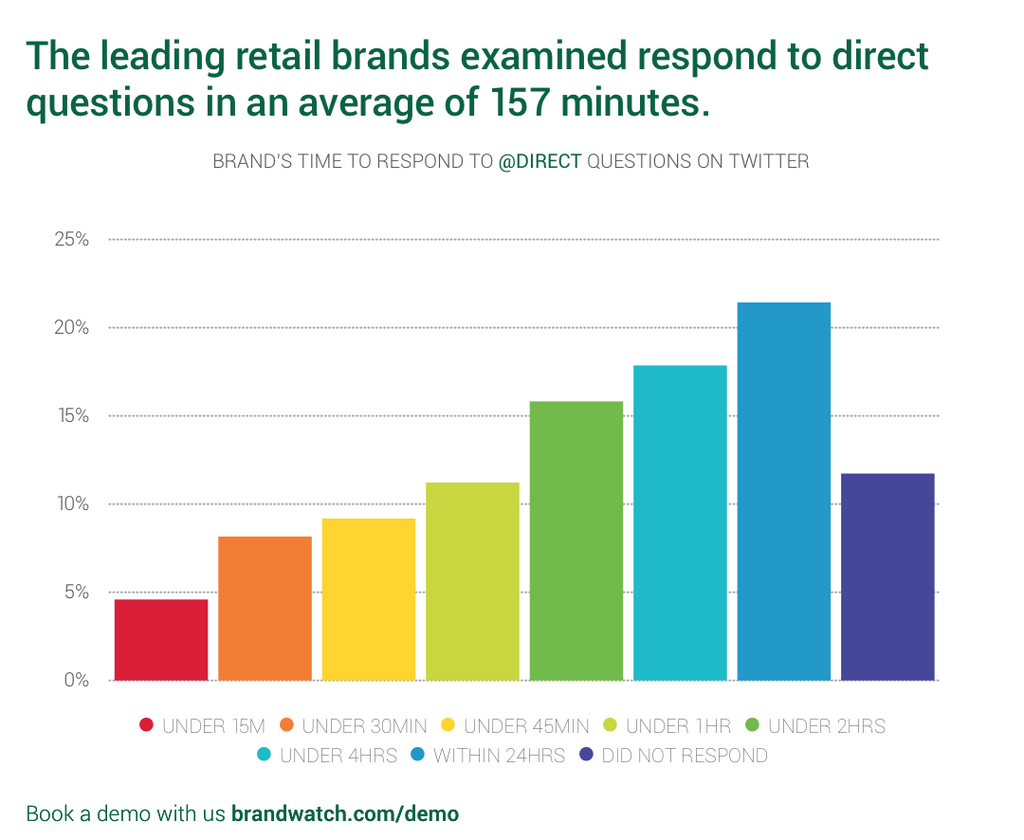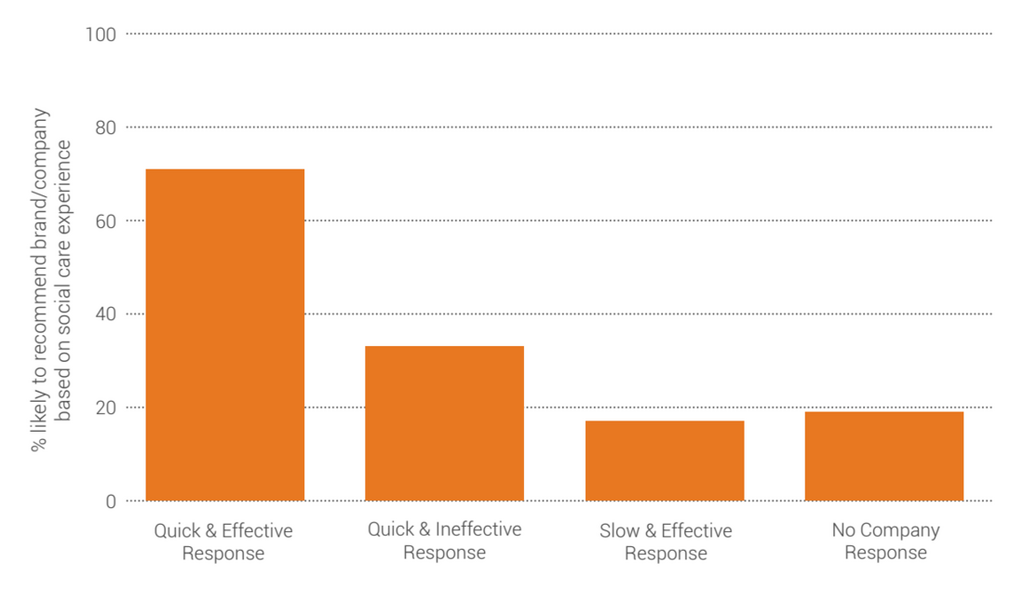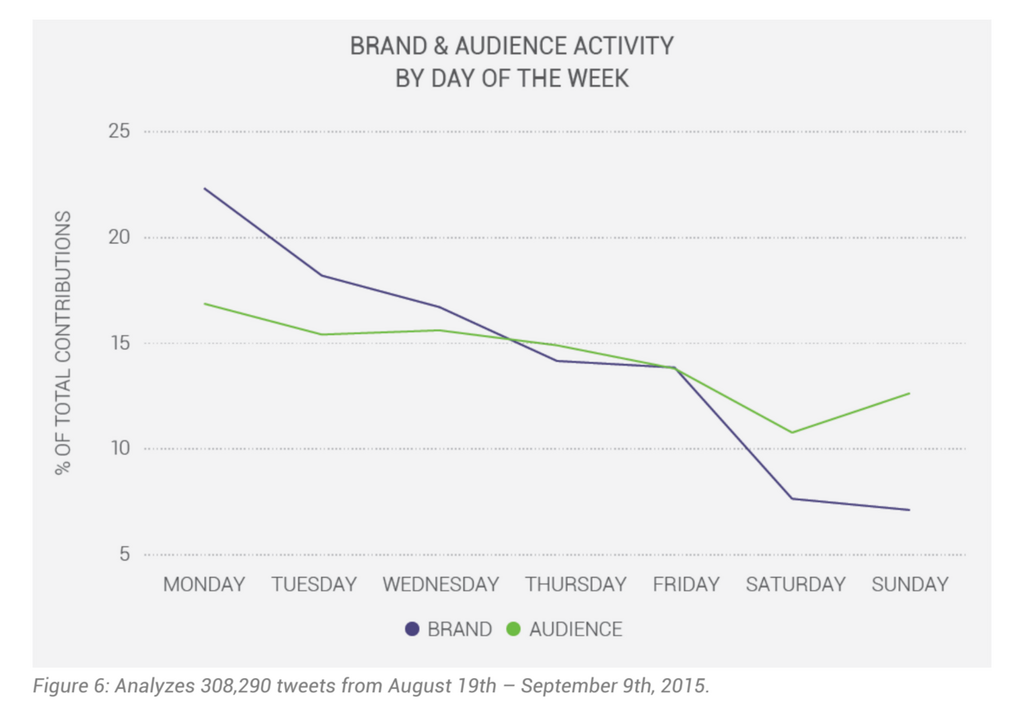10 Social Listening Tools and Who They’re Best for
By BrandwatchJul 14
Join us and boost your social media potential with our data-led event
Published April 7th 2016
Saving money, quicker response times and happier customers: it’s no wonder social media customer service is growing at a rapid pace.
According to a recent Dimension Data report, 35% of all contact centre interactions are already digital and if growth continues at the current rate it will overtake telephone contact by 2017.
Social customer service costs around $1 per interaction, six times cheaper than phone support costs.

While the cheaper cost of conducting customer care digitally might be expected to be the driving factor, in large part it is driven by consumers themselves.
It is this consumer demand that is making social customer service absolutely necessary, rather than desirable.
Social media is already the preferred customer service channel for millennials, and it is growing in popularity for older groups too.
Research conducted by Twitter shows 80% of users had @mentioned a brand during the 6-month study duration. Twitter reports that customer service interactions have increased by 2.5 times in the last two years.
Stakeholders might read these numbers and think “we have Facebook and Twitter accounts, we’re covered”. The problem is that most of the conversations don’t happen on these owned channels, important though they are.
Despite the huge number of Twitter users that contact brands, our research shows that up to 96% of online conversion about brands happen outside their official channels.
Among respondents to one survey, of people who have ever attempted to contact a brand’s customer support channel through social media, 32% expect a response within 30 minutes. A further 10% expect a response within 60 minutes. The expectation doesn’t stop there: 57% of respondents expect the same service at night or on the weekend.
The reality is majority of brands are failing to respond in anywhere near this timeframe.
Our research into the response times of retail brands shows that on average it takes 157 minutes for a response.

Not responding can be dangerous. Gartner reports that the dissatisfaction stemming from failure to respond can lead to a 15% churn rate for existing customers.
Consumers expectations have increased to seemingly unrealistic or undeliverable levels. In order to embrace this shift, brands need to be always listening by investing in social listening platforms and employing social media customer care teams.
The good news is the benefits don’t just stop at answering customer issues in a timely manner.
Done right, social media customer care will benefit both parties. A McKinsey report states the move to social can instigate a ‘paradigm shift in customer satisfaction’, and cites a mobile operator that reduced call centre volume by 20% in eight months, lowered costs, and increased their Net Promoter Score.
According to an NM Incite survey of social media users, 33% of respondents would recommend a brand that offered a quick but ineffective response, nearly double the number (17%) who’d recommend a brand that offered a slow but effective solution.
In fact, more people would recommend a brand that didn’t respond at all (19%) than those that received an effective but slow response.

If responses need to be quick and personal, staff need to be trained and trusted to answer any customer issue. Staff should be given the power to answer issues themselves rather than waiting for approval from senior staff.
The rise of social media has made brand messaging more conversational. This should extend to social customer care. Consumers prefer to deal with real people rather than faceless corporations. Great customer care should be human, personal and empathetic.
The growing number of brand responses that feature a name or initials of the staff member highlights this human touch. Humorous responses also help to serve this function. Humour isn’t always appropriate, but can work well where it is, as this example from UK supermarket Sainsbury’s shows.

Going beyond what is expected can create brand advocates and provide some fantastic PR. A humanized brand with empowered employees is able to deliver customer service on a level unexpected by consumers.
A case study in going above and beyond is the story of Peter Shankman, who jokingly asked for his favourite restaurant to deliver him a steak while he waited for a flight. To his surprise, when his plane landed two hours later he was greeted by a Morton’s server with a 24 oz. Porterhouse steak.
Hey @Mortons – can you meet me at newark airport with a porterhouse when I land in two hours? K, thanks. :)
— Peter Shankman (@petershankman) August 17, 2011
Oh. My. God. I don’t believe it. @mortons showed up at EWR WITH A PORTERHOUSE! http://t.co/bD8k4r0 # OMFG!
— Peter Shankman (@petershankman) August 18, 2011
When Twitter users mention a brand without tagging them, over 96% of those mentions are ignored by brands. This mirrors the proportion of customers – 96% – who are unhappy with the service but don’t complain.
The best customer service is a proactive one, helping customers before they even reach a call center or customer care social channel. The only way to listen out for these mentions is to employ a social listening platform.

Using Brandwatch’s Alerts and automated Signals, brands can be alerted to negative mentions and deal with the issue before it escalates into a negative PR story.
These tools can also be used to drive new business in addition to reducing churn. Laterooms.com uses social media to run Concierge, a service which offers help, advice and inspiration to customers about their trips and hotels.
Laterooms also uses Brandwatch to spot opportunities to join in the conversation, and where appropriate, steps in to offer its expertise on the topic at hand. Of all enquiries the Concierge service deals with, 30% go on to become sales.
Moving conversations from social media to private channels will be necessary sometimes, but taking everything offline can make it look like you’re hiding. Asking customers to call or email unnecessarily can frustrate, and take away the value of social media customer service. Evidence suggests using multiple channels leads to lower satisfaction.
Social listening can also inform you when your audience are most active, allowing brands to maximize efficiency: reducing waiting times and increasing response rates. The below chart, taken from our luxury fashion report, demonstrates the potential in this area.

Consumers now expect to be able to contact a company using a method of their choosing. Slow to act brands risk being left behind as more and more customer care moves online. But it isn’t this fear that should motivate them, rather the promise of benefits to be had.
Although consumers have expectations that might at first seem unrealistic, a dedicated social team using a social listening platform can respond to their demands, and more. Worryingly, 40% of contact centers have no data analysis tools in place, despite the industry recognizing these tools as the top factor that will shape change over the next five years.
Properly implemented, social media customer service should benefit both parties. Of course, the primary advantage to brands is increased customer satisfaction. Companies using Twitter for customer service see a 19% lift in customer satisfaction.
In one study, customers who received replies to Tweets were more satisfied with their experience, more willing to recommend the company, and willing to pay more in the future. The faster the response, the more the customer was willing to pay.
Listening to the whole web rather than just social media, companies can take advantage of even more benefits, including reduced costs, finding new sales opportunities, and the potential to create brand advocates.
Offering up analysis and data on everything from the events of the day to the latest consumer trends. Subscribe to keep your finger on the world’s pulse.
Existing customer?Log in to access your existing Falcon products and data via the login menu on the top right of the page.New customer?You'll find the former Falcon products under 'Social Media Management' if you go to 'Our Suite' in the navigation.
Brandwatch acquired Paladin in March 2022. It's now called Influence, which is part of Brandwatch's Social Media Management solution.Want to access your Paladin account?Use the login menu at the top right corner.